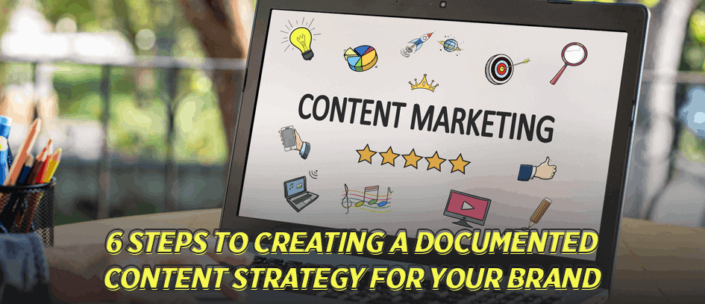Even though most of us digital marketers know that content marketing is deeply important for our digital marketing strategies, there’s a strong temptation to simply wing it, and see what happens.
We’ll think of a topic that would be great for a blog post one morning, write the post that afternoon, and post it before we sign off for the day. We’ll see an interesting article and tweet it to our followers, whether or not it fits into a larger strategic plan. We’ll reply to a few Facebook comments and share the blog post we just wrote with our followers.
Then we’ll start this process all over again the next day.
While this may be content marketing – in a sense – it’s certainly not strategic. It’s reactive, a fly-by-night approach to what should be a much more thought-out and planned process.
After all, if you’re putting resources into creating and sharing content, you ought to be striving for the highest ROI possible. And while this reactive social behavior is a part of attaining that, it’s certainly not enough on its own.
So what are you waiting for? Here’s a 6-step process to creating a documented content strategy.
1. Put the brakes on creation.
It may sound counterintuitive, but the first thing you want to do when developing a documented content strategy is to stop creating new content – just for a while.
This is because you want to free up your time to focus everything on putting together your new strategy.
After all, one of the reasons you’re creating this strategy in the first place is to ensure that you don’t waste resources on content that’s not working for you. If you’re still putting in hours on developing blog posts, you may find that, once you’ve finished your strategy, those blog posts don’t fit in with the direction you want to go.
To keep your social media feeds fresh during this time, consider scheduling posts of some of your older or evergreen content, or focusing more heavily on sharing curated content.
2. Determine your audience personas – whom you’ll be trying to reach with your content.
One frequent issue experienced by brands that don’t have a documented content strategy is that they’re just guessing when it comes to who their audiences are and what kind of content they want to see.
For instance, you may know that one of your brand’s audiences is young women – but that doesn’t tell you that much.
To really begin creating content that succeeds, that converts site visitors into customers, you need to know who, specifically, you’re trying to reach. To do that, you need to create your audience personas.
I won’t go into depth here, because creating audience (or buyer) personas is an extensive process, but basically, you’ll be creating a hypothetical person to represent each of your target audiences.
Audience personas are huge when creating a documented #contentmarketing strategy. Click To TweetIf one target audience is young women, you would develop a female persona in the age range that you’re targeting. Give her a name, a job title, and job description, income level, geographic location, hobbies, which social media platforms she uses, where she hangs out online, and any other details you can add. This becomes something you can refer back to when you’re trying to think of content topics that will appeal to your real-life customers.
For a full run-down of this important exercise, read our post “The Ultimate Guide to Buyer Personas.”
3. Brainstorm content ideas and formats.
Once you’ve gotten your buyer personas figured out, it’s time to start brainstorming content.
One of the great things about having your buyer or audience personas sketched out is you should find it easier to come up with solid topics.
You can go about this in one of two ways. You can simply brainstorm topics that land all over the map, and figure out how they fit with each persona later. Or you could go through each persona, and brainstorm content specifically for that persona.
If you’re having trouble coming up with blog post ideas – and who among us hasn’t, at one point or another – there are a few helpful tools out there that can help you.
One is HubSpot’s Blog Topic Generator. All you have to do is put in between 1 and 3 nouns, and the generator will come up with 5 different blog post titles to get you started. I put in the keyword “digital marketing” and got these results:
Source: HubSpot
Another fun one is the Blogabout blog topic generator, which has you fill in one or two blanks to create a blog post title.
Of course, you don’t have to resort to online tools to come up with great topics.
You can always do it the old-fashioned way.
Ask your colleagues what they’ve been reading about online.
Keep a bookmarks folder of blog posts that you find memorable or compelling.
Jot down ideas as they come to you, whether or not you need to come up with content right then (because that’s another amazing benefit of creating a documented content strategy – no more having to come up with content ideas every single day).
Your goal is to come up with enough content ideas – blog posts and/or webinars, whitepapers, e-books, etc. as well as social media posts – to last you a month. If you can initiate this process and keep up with it, you’ll always be a month ahead as far as knowing what content is coming down the pipeline.
4. Map your content to your personas and the customer buying journey.
Once you’ve developed a substantial stable of content ideas, you’ll want to map each piece of content to the appropriate buyer persona. This is in order to ensure that you maintain a balance of content types, as well as balanced outreach to your various different customer groups.
In addition, it’s helpful to know where your various content items fall on the customer journey. These ought to be fairly balanced, as well.
Do you have blog posts that will appeal to people who’ve never heard of your brand, and stumble upon it through a social ad or a link shared by a friend?
How about content for people considering purchasing your product or service? And for current customers whom you want to retain?
Chances are, you’ll already have topics and formats that will appeal to people at each of these points from your brainstorming session, but if you don’t, take some time to fill in the gaps.
5. Plan which channels you’ll be focusing on and create a schedule or timeline.
Thanks to those incredible buyer personas you spent so much time creating, as well as your analytics, you should know where your audience divides its time online.
Use that information to decide which social media channels you’ll focus on when it comes to sharing your content. There are Facebook and Twitter, of course, but how about Pinterest? Highly visual products often perform exceptionally well there. How about Instagram? Snapchat?
Once you’ve decided where you’ll focus your energies, it’s time to create a schedule or timeline.
This is where social media management tools can come in handy. Using a tool like Hootsuite or Buffer, you can create and schedule posts on multiple channels, all on one dashboard. This can be extremely helpful if you’re wanting to push out multiple posts per day, or several posts on different channels.
Whether or not you’re using a social media management tool, you’ll want to keep a spreadsheet listing your content titles/topics, formats, platforms, and when they should go out.
6. Follow through.
This is both the easiest and the hardest part of developing a documented content strategy: sticking to it.
That doesn’t mean that you need to write each month’s posts and schedule date in stone. Far from it – it’s vital that you build in some flexibility in case a great content opportunity comes up, like the chance to guest post on a popular blog, or a newsworthy event offers a chance to write a timely opinion post.
However, for this strategy to work, you do need to make a concerted effort to follow through on all the great ideas you’ve put into it. This will take practice, but once you’ve gone through a month or two, it’ll simply become a habit.
Want to learn more about successful content marketing? Read our post “21 Common Questions About Content Marketing Answered.”







